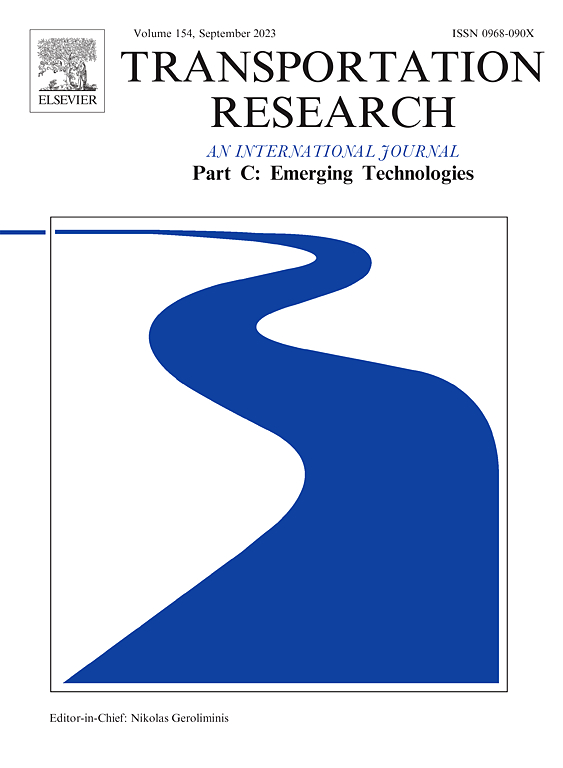Research on rebalancing of large-scale bike-sharing system driven by zonal heterogeneity and demand uncertainty
IF 7.6
1区 工程技术
Q1 TRANSPORTATION SCIENCE & TECHNOLOGY
Transportation Research Part C-Emerging Technologies
Pub Date : 2024-11-26
DOI:10.1016/j.trc.2024.104933
引用次数: 0
Abstract
Bike-sharing, as an open and intricate system, encompass a vast and diverse array of data, and are often affected by various time-varying and uncertain factors. Consequently, employing scientific and appropriate rebalancing in the age of big data is pivotal for the system’s sustained and healthy development. This paper takes the dockless bike-sharing system as the research object, considers regional heterogeneity and time-varying demand uncertainty, and proposes a rebalancing strategy that integrates initial inventory determination and remaining inventory uncertainty. Firstly, this paper considers using of Poisson distribution chi-square tests to assess the borrowing and returning behaviors within a zone, selects a unit time tailored to the zone’s unique circumstances to estimate the parameter rate, and independently establishes a non-stationary Markov chain for each zone to determine the initial expected inventory under dynamic zonal demand conditions. Using big data from bike-sharing operations in Nanjing for empirical validation, the results indicate that borrowing and returning behavior in most zones follows a Poisson distribution, and that zones with higher volumes of traffic have fewer bikes initially deployed. Secondly, we address the uncertainty of demand-driven residual inventory and spatial correlations, formulating a robust two-stage optimization model aimed at minimizing the worst-case scenario. We then transform this model into a computationally tractable form using polyhedral uncertainty sets. By analyzing the model structure and mathematical properties, we develop a column-and-constraint generation algorithm for customizing a two-stage robust optimization model based on residual inventory, and compare it with other traditional algorithms. The numerical experimental results show that the proposed model and algorithm have significant advantages in terms of solution accuracy and efficiency, and can play a role in real-world problems. Finally, the paper discusses the impact of various parameters in the model on the solution, yielding results consistent with our expectations.
分区异质性和需求不确定性驱动的大规模共享单车系统再平衡研究
共享单车作为一个开放的、错综复杂的系统,包含了大量、多样的数据,往往受到各种时变、不确定因素的影响。因此,在大数据时代采用科学、适当的再平衡对系统的持续健康发展至关重要。本文以无桩共享单车系统为研究对象,考虑区域异质性和时变需求不确定性,提出了一种综合初始库存确定和剩余库存不确定性的再平衡策略。首先,本文考虑利用泊松分布的卡方检验来评估区域内的借还行为,根据区域的特殊情况选择单位时间来估计参数率,并为每个区域独立建立非平稳马尔可夫链,以确定动态区域需求条件下的初始预期库存。利用南京共享单车运营的大数据进行实证验证,结果表明,大部分区域的借还行为遵循泊松分布,交通流量较大的区域初始投放的单车数量较少。其次,我们解决了需求驱动的剩余库存和空间相关性的不确定性问题,制定了一个稳健的两阶段优化模型,旨在最小化最坏情况。然后,我们利用多面体不确定性集将该模型转化为可计算的形式。通过分析模型结构和数学特性,我们开发了一种列和约束生成算法,用于定制基于残余库存的两阶段鲁棒优化模型,并与其他传统算法进行了比较。数值实验结果表明,所提出的模型和算法在求解精度和效率方面具有显著优势,可以在实际问题中发挥作用。最后,本文讨论了模型中各种参数对求解的影响,结果与我们的预期一致。
本文章由计算机程序翻译,如有差异,请以英文原文为准。
求助全文
约1分钟内获得全文
求助全文
来源期刊
CiteScore
15.80
自引率
12.00%
发文量
332
审稿时长
64 days
期刊介绍:
Transportation Research: Part C (TR_C) is dedicated to showcasing high-quality, scholarly research that delves into the development, applications, and implications of transportation systems and emerging technologies. Our focus lies not solely on individual technologies, but rather on their broader implications for the planning, design, operation, control, maintenance, and rehabilitation of transportation systems, services, and components. In essence, the intellectual core of the journal revolves around the transportation aspect rather than the technology itself. We actively encourage the integration of quantitative methods from diverse fields such as operations research, control systems, complex networks, computer science, and artificial intelligence. Join us in exploring the intersection of transportation systems and emerging technologies to drive innovation and progress in the field.

 求助内容:
求助内容: 应助结果提醒方式:
应助结果提醒方式:


